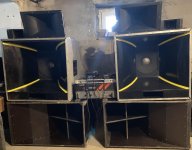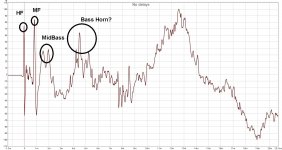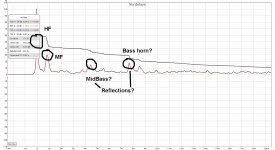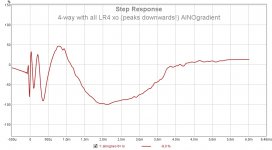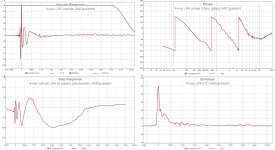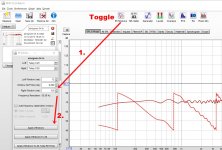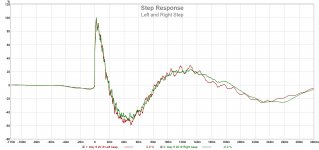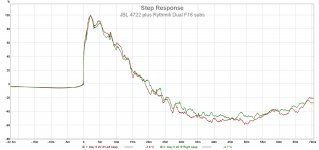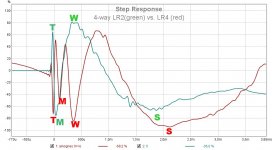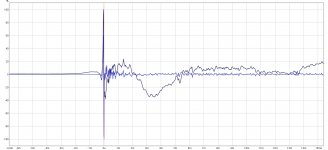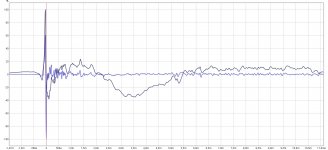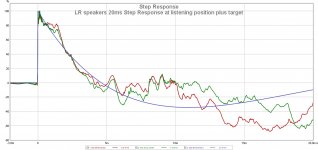REW is a brilliant piece of software. I am using it some 2 months and I am still scratching the surface. I use two 4ch DSPs t.racks DSP 4x4 mini to implement the crossover . It is slightly limited on the slopes (Besel, Butterworth and LR up to 24dB/oct), but there is a 7 band parametric EQ and up to 680 ms delay per channel. Another slight disadvantage is that some of the adjustments are in steps, but I can get really close to what is needed.
I first tried to set up everything with LR24 and measure the delays relative to the tweeter. The result is in the attachment. I liked the result. It sounds definitely better than without the delays. The crossover points are slightly different from the below.
Then, I discovered the JMLC transient perfect crossover and tried to set up that one. This time I tried to adjust by the spectrogram. There is definitely a problem in the LF, I did it wrong and it will be corrected later. The Fr points are 150, 550 and 5500 Hz, calculated points for the alignment are 130.9, 477.4 and 4700 Hz for the LP filters (slightly deviate from the theoretical due to steps in the DSP setup) and 172.7, 630 and 6200 Hz for the HP filters. The calculated delays for the speakers are 1.47 ms for the midbass, 1.87 ms for the mid horn and 1.91 ms for the tweeter. Polarity LF to HF - normal, inverted, normal, inverted.
The actual values in the DSP in the measurement are 12, 14 and 15 ms, I tried a few times adjust to have what I think is a nice spectrogram - I messed up the bass, it is ca 7 - 8 ms too much.
The plan is to measure the delays relative to the tweeter and add these with the calculated values. Also, due to filter and crossover point changes, I need to readjust the levels using pink noise and RTA.
I would appreciate any comments and tips on how to use the REW tools to adjust everything perfectly delay wise. The results will not be perfect probably due to other things, but that will be as good as it gets for now, all the horns will be replaced by better versions in future and the room treated as well.
Edit: Some more information is in this thread: 4 way active horn speaker crossover - any help/opinion appreciated (incl. REW files). I think this deserves a new thread, but if the mods are of a different opinion, these two could be merged. Thanks.
I first tried to set up everything with LR24 and measure the delays relative to the tweeter. The result is in the attachment. I liked the result. It sounds definitely better than without the delays. The crossover points are slightly different from the below.
Then, I discovered the JMLC transient perfect crossover and tried to set up that one. This time I tried to adjust by the spectrogram. There is definitely a problem in the LF, I did it wrong and it will be corrected later. The Fr points are 150, 550 and 5500 Hz, calculated points for the alignment are 130.9, 477.4 and 4700 Hz for the LP filters (slightly deviate from the theoretical due to steps in the DSP setup) and 172.7, 630 and 6200 Hz for the HP filters. The calculated delays for the speakers are 1.47 ms for the midbass, 1.87 ms for the mid horn and 1.91 ms for the tweeter. Polarity LF to HF - normal, inverted, normal, inverted.
The actual values in the DSP in the measurement are 12, 14 and 15 ms, I tried a few times adjust to have what I think is a nice spectrogram - I messed up the bass, it is ca 7 - 8 ms too much.
The plan is to measure the delays relative to the tweeter and add these with the calculated values. Also, due to filter and crossover point changes, I need to readjust the levels using pink noise and RTA.
I would appreciate any comments and tips on how to use the REW tools to adjust everything perfectly delay wise. The results will not be perfect probably due to other things, but that will be as good as it gets for now, all the horns will be replaced by better versions in future and the room treated as well.
Edit: Some more information is in this thread: 4 way active horn speaker crossover - any help/opinion appreciated (incl. REW files). I think this deserves a new thread, but if the mods are of a different opinion, these two could be merged. Thanks.
Attachments
-
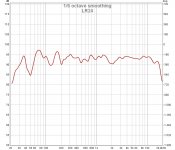 LR24 FR.jpg107.9 KB · Views: 270
LR24 FR.jpg107.9 KB · Views: 270 -
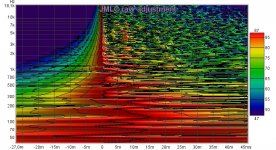 JMLC raw adjustment.jpg221 KB · Views: 116
JMLC raw adjustment.jpg221 KB · Views: 116 -
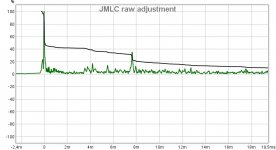 JMLC raw adjustment filtered IR.jpg64.9 KB · Views: 113
JMLC raw adjustment filtered IR.jpg64.9 KB · Views: 113 -
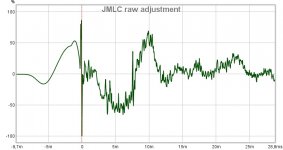 JMLC raw adjustment - IR.jpg59.2 KB · Views: 108
JMLC raw adjustment - IR.jpg59.2 KB · Views: 108 -
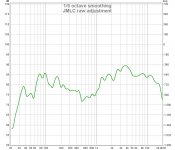 JMLC raw adjustment FR.jpg111.4 KB · Views: 249
JMLC raw adjustment FR.jpg111.4 KB · Views: 249 -
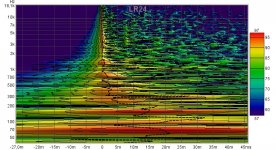 LR24 spectrogram.jpg217.9 KB · Views: 258
LR24 spectrogram.jpg217.9 KB · Views: 258 -
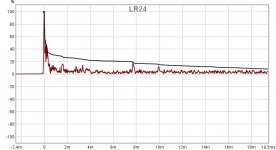 LR24 filtered IR.jpg63.3 KB · Views: 254
LR24 filtered IR.jpg63.3 KB · Views: 254 -
 LR24 IR.jpg55.5 KB · Views: 260
LR24 IR.jpg55.5 KB · Views: 260
Last edited:
Looks like your measurements were taken quite far from the speaker. To set delays right, take only nearfield measurement on-axis, at say 30-50cm from( the large) speaker, speaker on a stand in a large room or outdoors.
Look at step response. Play one way at the time and then pairs T+M and M+W, then all three. Look at them in overlay view. With LR4 xo peaks should point in same direction successively and make zigzag. Tweeter is first on the left. Then start playing with delay, first set eg. 1.00ms to all of them. Then gradually add delay to the higher one in a pair, start frrom M+T. When a pair is ok, set the lower pair W+M, now reduce delay of woofer! When al pairs are ok, measure the whole speaker (or W+M+T)
Subwoofer-woofer delay is most difficult to measure and set, painful really. Easiest solution is to set same delay and polarity as woofer and let it be. When polarity of one driver is flipped, the step peak turns around and there should be a notch(es) in response around xo freq(s). Remember to save settings!
Return to this some other day and remeasure everything. When you think that inter-driver delays are fine, set subwoofer delay to 0 and the rest with the differencies determined.
This takes lots of learning and doing, be patient!
Look at step response. Play one way at the time and then pairs T+M and M+W, then all three. Look at them in overlay view. With LR4 xo peaks should point in same direction successively and make zigzag. Tweeter is first on the left. Then start playing with delay, first set eg. 1.00ms to all of them. Then gradually add delay to the higher one in a pair, start frrom M+T. When a pair is ok, set the lower pair W+M, now reduce delay of woofer! When al pairs are ok, measure the whole speaker (or W+M+T)
Subwoofer-woofer delay is most difficult to measure and set, painful really. Easiest solution is to set same delay and polarity as woofer and let it be. When polarity of one driver is flipped, the step peak turns around and there should be a notch(es) in response around xo freq(s). Remember to save settings!
Return to this some other day and remeasure everything. When you think that inter-driver delays are fine, set subwoofer delay to 0 and the rest with the differencies determined.
This takes lots of learning and doing, be patient!
Last edited:
If you are not taking into account the natural rolloff and phase response of the drivers you will not achieve a true LR acoustic response. Textbook crossover circuits by themselves NEVER give the expected results.
Mike
Mike
Mike
Mike
Juhazi, thanks for the input - the procedure is clear. I will definitely have to spend some more time on this and not half an hour after midnight on a working day. You guessed correctly, this is at the listening position - ca 2.5 m from the speakers - and in the middle of the stereo triangle. The subwoofers are horns also, so the delay needs to be at least the length of the horn.
When I look at the numbers and measure the offsets, the calculated values are actually pretty close to what I would expect the numbers to be.
When measuring e.g. the HF, MF and LF - where should the microphone be located? I am posting a picture of the system in the attachment There are different MF horns now (wider coverage) and the HF horn is just on top of the MF horn.
Mike, I was quite happy with the LR24, the response is almost flat without any EQ (sans the bass influenced by the room). You are definitely right. The textbook setup is a good place to start at least in my opinion.
When I look at the numbers and measure the offsets, the calculated values are actually pretty close to what I would expect the numbers to be.
When measuring e.g. the HF, MF and LF - where should the microphone be located? I am posting a picture of the system in the attachment There are different MF horns now (wider coverage) and the HF horn is just on top of the MF horn.
Mike, I was quite happy with the LR24, the response is almost flat without any EQ (sans the bass influenced by the room). You are definitely right. The textbook setup is a good place to start at least in my opinion.
Attachments
I started to think about the size and physical distances...
It really gets tricky with this large systems. Keep mic at 1m at listening height, same point for wmt measurements. Focus on step response, scale display window to see first 10ms. First ones on left are direct impulses, reflection appear after 4-5ms and make analysis difficult.
Ground plane mic position eliminates floor bounce, use it for s-w analysis.
It really gets tricky with this large systems. Keep mic at 1m at listening height, same point for wmt measurements. Focus on step response, scale display window to see first 10ms. First ones on left are direct impulses, reflection appear after 4-5ms and make analysis difficult.
Ground plane mic position eliminates floor bounce, use it for s-w analysis.
Thanks, appreciated! I will report back after the weekend. In the attachment, there is a measurement without any delays (still 2.5 m away). I think the MF spike is clear, not too sure about the other ones. Also, the MB level was a bit low, so I need to turn it up a bit.
Attachments
Here is step response of my 4-way actives with all-LR4 and proper delays. The speaker is physically pretty much time-aligned, but bass is floor-coupled and thus other drivers need 0,5ms more delay.
Each "way's" step response peak's width/spread comes from it's frequency range, tweeter peak is sharpest. When you flip polarity of one way, it's peak turns over, this way you can recognize it (when two or more are playing same sweep)
LR4 is easy for finding relative delays. Same delays are good starting point for other xo-topologies.
Each "way's" step response peak's width/spread comes from it's frequency range, tweeter peak is sharpest. When you flip polarity of one way, it's peak turns over, this way you can recognize it (when two or more are playing same sweep)
LR4 is easy for finding relative delays. Same delays are good starting point for other xo-topologies.
Attachments
Last edited:
REW is a brilliant piece of software. I am using it some 2 months and I am still scratching the surface.
No, man, go ahead.
There are simple and easy foolproof algorithms, but there are something harder, phase-align approaches.
Have no doubt, you’ll better to try both by yourself and choose only then.
Merlijn van Veen - Subwoofer Alignment: The foolproof relative / absolute method
Next you, being room-inside, are better to try something FIR-based.
BesPav: Thanks, interesting article.
Juhazi: How do I properly gate the measurements? By selecting proper window? Could you please give example settings? I read about gating in REW before, but did not find a way to do it.
Juhazi: How do I properly gate the measurements? By selecting proper window? Could you please give example settings? I read about gating in REW before, but did not find a way to do it.
REW manual doesn't tell it too easily
Impulse Responses
But perhaps this helps, first toggle the IR button! You can also go to settings and save a preset for right window gating etc. parameters.
Impulse Responses
But perhaps this helps, first toggle the IR button! You can also go to settings and save a preset for right window gating etc. parameters.
Attachments
A bit confused, if the drivers are time aligned, then the step response should show that as a single step like the following 3 way that has been time aligned. Also see Measuring Loudspeakers, Part Two Page 3 | Stereophile.com
Maybe I am not understanding...?
Maybe I am not understanding...?
Attachments
Left window length is irrelevant in this regard, but at least 2ms is needed to catch possible "pre-ringing"
That single peak step response is not possible for multiway speakers using symmetric topology, without FIR tricks. Mitchba's graphs show 300ms instead of the 6ms I showed... "Time aligning" physically/acoustically is one thing, crossover topology and consequent step response another. If one wants single peak step response without FIR, this is one possibility - S. Harsch XO
LR2 topology makes step response look "better", because peaks are not following but combining. This can be transferred to group delay and phase shifts graphically, the mathematics behind is the same thing (impulse response), just different presentation with FFT
Loudspeaker step response measurement and explanation
Subtractive Crossover Networks
https://www.ele.uri.edu/courses/ele314/handouts/YS06_Classicfilters.pdf
Linkwitz–Riley filter - Wikipedia
Linkwitz-Riley Crossovers: A Primer
My 4-way with all LR2 vs. all LR4 step responses
That single peak step response is not possible for multiway speakers using symmetric topology, without FIR tricks. Mitchba's graphs show 300ms instead of the 6ms I showed... "Time aligning" physically/acoustically is one thing, crossover topology and consequent step response another. If one wants single peak step response without FIR, this is one possibility - S. Harsch XO
LR2 topology makes step response look "better", because peaks are not following but combining. This can be transferred to group delay and phase shifts graphically, the mathematics behind is the same thing (impulse response), just different presentation with FFT
Loudspeaker step response measurement and explanation
Subtractive Crossover Networks
https://www.ele.uri.edu/courses/ele314/handouts/YS06_Classicfilters.pdf
Linkwitz–Riley filter - Wikipedia
Linkwitz-Riley Crossovers: A Primer
My 4-way with all LR2 vs. all LR4 step responses
Attachments
Last edited:
I use the JMLC transient perfect (18 BW with shifted FR points and some delay) topology and by tuning the delays I got this. That does not look too bad to me. The HF/MF alignment was really simple, I played around with the delay until there was only one spike with no jumps on the curve up and down. I am not too sure about the bass and sub alignment.
Unfortunately I found out in the process, that something really strange happened to my MF drivers 🙁 https://www.diyaudio.com/forums/multi-way/341868-jbl2445-drives-fail-yes.html#post5894086
Unfortunately I found out in the process, that something really strange happened to my MF drivers 🙁 https://www.diyaudio.com/forums/multi-way/341868-jbl2445-drives-fail-yes.html#post5894086
Attachments
I'm personally not at all interested in "transient-perfect" quest. I did some experiments for that with minidsp and 3-way, but it was a mess, sound was strange and pre-ringing in impulse... It might be fine with a 2-way.
LR2 with good phase match 1 octave before and past xo point just sounds wonderfully good (eg. grand piano) and is reasonably easy to achieve with dsp multiway. I prefer LR2 over LR4 for the subwoofer in my HT too!
LR2 with good phase match 1 octave before and past xo point just sounds wonderfully good (eg. grand piano) and is reasonably easy to achieve with dsp multiway. I prefer LR2 over LR4 for the subwoofer in my HT too!
Not sure what you are saying Juhazi. The step response on the left in my post above is over 70ms, the one on the right is 300ms. It is to accommodate my subs that go down to 6Hz in my room. It is a 3 way system, but the single "step" indicates perfect time alignment, as shown by the links you referenced.
Here is another one over 20ms for a 3-way without subs. Perfectly time aligned against the target response of an ideal loudspeaker (without room). Measured at the LP and stays time aligned across a 6' x 2' area where my couch is. No pre-ringing on either speakers. I use linear phase XO as they sum perfectly in the frequency and time domain as per: http://www.acourate.com/XOWhitePaper.pdf
pelanj, on the REW forum and here, member jtalden has a REW guide for time aligning drivers if that is what you are looking to do. I can see from your post, you are on your way. Good luck!
Here is another one over 20ms for a 3-way without subs. Perfectly time aligned against the target response of an ideal loudspeaker (without room). Measured at the LP and stays time aligned across a 6' x 2' area where my couch is. No pre-ringing on either speakers. I use linear phase XO as they sum perfectly in the frequency and time domain as per: http://www.acourate.com/XOWhitePaper.pdf
pelanj, on the REW forum and here, member jtalden has a REW guide for time aligning drivers if that is what you are looking to do. I can see from your post, you are on your way. Good luck!
Attachments
Not sure what you are saying Juhazi. The step response on the left in my post above is over 70ms, the one on the right is 300ms. It is to accommodate my subs that go down to 6Hz in my room. It is a 3 way system, but the single "step" indicates perfect time alignment, as shown by the links you referenced.
Here is another one over 20ms for a 3-way without subs. Perfectly time aligned against the target response of an ideal loudspeaker (without room). Measured at the LP and stays time aligned across a 6' x 2' area where my couch is. No pre-ringing on either speakers. I use linear phase XO as they sum perfectly in the frequency and time domain as per: http://www.acourate.com/XOWhitePaper.pdf
pelanj, on the REW forum and here, member jtalden has a REW guide for time aligning drivers if that is what you are looking to do. I can see from your post, you are on your way. Good luck!
The author of that paper seems confused, he refers to Butterworth filters: Butterworth filter - Wikipedia, but then describes LR filter alignments: Linkwitz–Riley filter - Wikipedia.
What gives?
Mike
- Status
- Not open for further replies.
- Home
- Design & Build
- Software Tools
- REW for multiway horn crossover delay analysis and tuning
